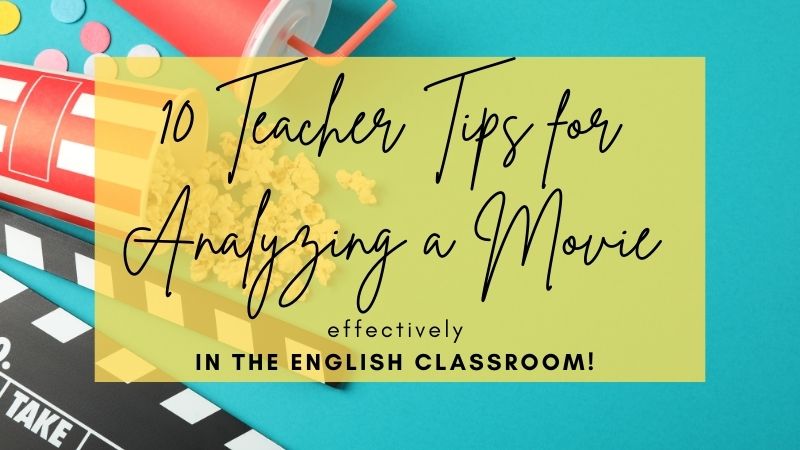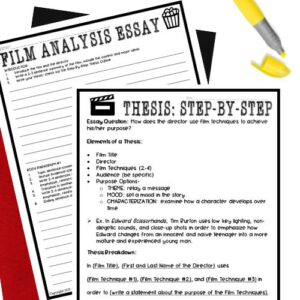I LOVE watching movies more than grabbing a book or turning on a podcast or listening to the radio. Even as an English teacher, my first go-to when I need to completely relax after a tough day of teaching is to turn on a movie and eat chocolate…or consume really any sweet snack. Likewise, most of my students would prefer a film or some type of media to most other forms of entertainment. While sometimes analyzing a movie requires focus and critical thinking, one great thing is that you can, if you want, simply sit down and enjoy the ride.
Over the last century, so many films have been created that have had a lasting impact on audiences everywhere. Yes, books are vital to education; however, units that require analyzing a movie also demand a place in the literary canon.
I am not saying that educators should use films to fill time, avoid teaching, or employ them as a substitute for good literature. Instead, we should use them sparingly, engagingly, and purposefully when it makes sense to teach or reinforce a skill or idea in connection to reading, writing, listening, speaking, and presenting!
Continue reading below for 10 Teacher Tips for Analyzing a Movie Effectively!!
Need help with Test Prep? Check out this FREE Pack of 3 Test Prep Activities to help students achieve success on standardized tests!

10 Teacher Tips for Analyzing a Movie Effectively
1. Choose quality films.
If you ask a teenager about his or her favorite movies, you will get a ton of enthusiastic responses. Unfortunately, so many of our students only see films as a source of cotton candy entertainment. They think a movie is good because it is funny, clever, loud, action-packed, fantastical, realistic, etc. The list of characteristics goes on and on.
Instead, consider including older films (before the 90s) that have stood the test of time. Sure, you can include an animated film clip once in a while; however, often students have already seen lots of these movies. Nothing is new to them except for movies that are older.
Now, you might have several students who are raised by an older generation familiar with more classic films. And that’s okay. Most of the time, these students LOVE being able to recognize movies their family members have already shown them! It’s like they know the secret code, and analyzing a movie then becomes even more engaging!
MY FAVORITE FILMS TO USE WHEN ANALYZING A MOVIE: (that my administrators have NEVER had a problem with, but you still may want to get permission for)
- 12 Angry Men
- Singing in the Rain
- To Kill a Mockingbird
- Ben-Hur
- West Side Story
- Mr. Smith Goes to Washington
- Gattaca
- Edward Scissorhands
- Indiana Jones and the Raiders of the Lost Ark
- Serenity
2. Connect to the standards.
I would make the argument that before you even choose a film, you should think about what your students need to learn. If your main goal is to share an AWESOME movie with your students that you LOVED growing up, I actually would advise against it.
The process of choosing a film should be similar to choosing a novel or play for your students. The message or entertainment value should not be the only elements you consider. Really, there should be a focus on timelessness, language, and complexity as well as appropriateness.
Films need to be taken more seriously as a part of the curriculum, so there MUST be standards connected to the lesson and activities that utilize full movies or clips.
TEACH CITING EVIDENCE
Let’s say that you want to teach CITING EVIDENCE. You want your students to “cite strong and thorough textual evidence to support analysis of what the text says explicitly as well as inferences drawn from the text” (Common Core Standards).
You could start with clips from 12 Angry Men. This iconic movie from 1957 tells the story of a boy on trial for his life. The 12 jurors spend almost the entire movie in a single room delving into the evidence. You could view the scenes that depict the jurors examining the evidence and have students identify the evidence that causes each juror to change his mind.
The biggest thing we want students to learn is that textual evidence is KEY, especially when analyzing a movie. Without evidence, you don’t have a good argument even if you FEEL like you do!
TEACH LITERARY ANALYSIS
Typically, mood, characterization, and theme are concepts students struggle with throughout the year. You can cover multiple standards by analyzing a movie!
Students don’t have to write a full paper, but if they can take the time to identify the mood from a particular scene and use details to support that mood then, CHECK, they have practiced with that standard!
If you want to up the ante, challenge them to connect the mood to the overall theme, which is the message of the film! Click here for easy-to-use film analysis materials that focus on mood, characterization, and theme!!
3. Prepare students ahead of time.
If you want to use movies in any way, I would encourage you to prepare your students to get in the mindset of analyzing a movie purposefully. It is NOT merely a break, “fun” time, or a moment to shut their eyes. That has happened to me more times than I can count.
Instead, prepare your students to think of analyzing a movie in the same way they would analyze a piece of literature.
There are many ways to begin this process:
- Discuss the title
- Check out the movie poster
- Watch the trailer
- View the first couple of minutes of several films
- Engage students with pre-viewing activities
- Share the final film analysis assignment
Each one of these activities requires critical thinking skills and a bit of preparation. Heck, if you want to make your life a bit easier when analyzing a movie, have students recommend good movie clips or trailers for you to use!
4. Use “reading” strategies while viewing.
Reading strategies are not JUST for articles or fiction. We can use them even when we are examining media and analyzing a movie!
TOP 15 STRATEGIES FOR “READING” A MOVIE:
- Read the title as the first step to predicting what will happen in a movie.
- Set a goal for “reading” so students have a purpose for analyzing a movie. This is where a goal can be established by the teacher or students can create self-directed goals. Check out these ready-made activities for goal setting.
- Watch the first and last parts of a scene to check for understanding.
- Write Out Vocabulary and identify words that students know, sort of know, and don’t know. Transfer this vocabulary to graphic organizers like these ones in order to go through and define the words in order for students to improve their understanding of the movie clips.
- Mention repeated ideas or even phrases in the movie. This makes it easier to see patterns within a film. If a director or screenwriter includes XYZ several times, then it’s likely that XYZ has a more significant meaning!
- Annotate the script to explain by making notes throughout. These can be short and sweet but should be clear about the content of the section that was just viewed.
- Focus on meaning so that students can ask basic but necessary questions. First, ask what does this mean? Followed by the question, how do I know? This will encourage students to infer meaning from the scene.
- Constantly question as you watch. Here is the opportunity to have students question the film scene using their prior knowledge. The goal of this approach is to better integrate the new movie clip and its ideas with already-established ideas and understanding.
- Rewatch the clip/scene including the most important parts. This is a great opportunity to return to the more significant elements as well as the notes they have already made.
- Connect to another text, passage, or idea. Making connections between texts will require students to integrate a new text, like a film, with their background knowledge. Try these 5 days of easy-to-teach paired passages with questions to help students with reading for comprehension.
- Reflect on what you watched. During and particularly after viewing a scene or clip, have students use prompts such as “I think…” or “I feel” in order to encourage making connections. This step will help students make more meaning for themselves.
- Talk about the movie. Have students discuss the movie together in small groups. Different backgrounds and experiences applied to an interpretation of a text can add more dimension to everyone’s understanding.
- Ask questions. The 5 Ws are a great start! Then shift to higher-order thinking questions such as “what might…” or “how will…” so students can dig deeper. The act of speculating tied to the movie will push students beyond the surface.
- Watch and Read other similar texts. In order to make meaning, students need prior knowledge so reading or watching around a topic or reading similar texts is an easy way to make this happen. This love in literature unit including poetry, a short story, and drama excerpts would be an ideal option. And if you want even more ideas check out this post about teaching literature thematically.
- Respond to the movie (what do you think?). The process of analyzing a movie can be straightforward by simply asking “What do you think?” Or you can increase engagement by including more creative options. This “Song of Myself” poetry activity and writing task helps students to connect with poetry, which is often difficult for reading comprehension.
5. Have an end goal in mind.
Before you begin, you might want to think about what you want your students to get out of analyzing a movie.
SOME QUESTIONS TO CONSIDER:
- Do you want them to understand what they have seen? (Reading Comprehension)
- Do you want them to be able to create a script of their own? (Narrative Writing)
- Do you want them to synthesize the movie with other texts/forms of media? (Research)
- Do you want them to analyze film techniques or rhetorical strategies used throughout? (Informative Writing)
- Do you want them to be able to reenact a scene or extend the movie’s ideas? (Presentation)
Throughout the entire time of analyzing a movie, be sure to reinforce this goal!
6. Select the film and/or clips several weeks out.
If you choose to go through with analyzing a movie, take your time. Send home permission slips, even if the movie is PG, G, or NR (not rated). There is always one parent or guardian or administrator who could object.
Really, it is BEST to include any possible movie viewings in the syllabus…if you can. Many districts outline major texts ahead of time, and usually, books with good film options like Romeo and Juliet as well as To Kill a Mockingbird are mainstays. I get that this scenario sounds implausible, so if you can, at least give students and parents/guardians several weeks to prepare.
Trust me; it will only save you the inevitable hassles as you incorporate analyzing a movie.
SIDE NOTE: If I use clips, I usually don’t send home any permission slips. That’s just me; be sure to check out your school’s policies.
7. Give time to discuss.
We rarely give time for students to think, I mean really think about what they see, hear, or read. And this situation is all too true when it comes to watching something versus analyzing a movie. Think about it for a moment.
You are sitting inside of the movie theater and the movie clearly ends. The credits start rolling. So you gather your purse, trash, and jacket and start to leave the theater. The experience is done. You are ready to go and move on with your life.
Instead, I will sometimes just sit. I wait for others in the audience to make their way toward the exits. Some movies deserve thought, and I would argue that if you are going to invest two hours and your financial resources into a movie, then you should take the time to sit with the movie for a while.
After every movie growing up, my family would give it a rating of A-F and discuss its high and low points. You could simply start with that in your classroom. Let students chat with a classmate or small group about a film or specific scene and simply rate it. Don’t merely accept that the film is good/bad or even valuable because a teacher says it is.
Beyond their own viewpoint, challenge students to go more deeply into the worth of the movie in terms of acting, major themes, relevance, symbolism, etc. You want students to dig past the fluff. Why is the scene or movie relevant at a specific time or even today? What message does it send and is this message even significant? What rhetoric (even if the movie is fiction) does the director use throughout beyond simply entertaining an audience?
We want our students to think and move beyond the surface when analyzing a movie. They MUST use evidence and NOT their feelings to say something.

8. Write a reflection/review.
After the initial discussion, let students write. You can provide examples from various review sites and examine those first.
However, we want to engage with real-life situations, and movie reviews are all over the place nowadays. EVERYONE has an opinion, but letting students reflect and write about a movie with evidence to support their ideas is VITAL.
You could even have students use other reviews as a basis and then negate or support a specific viewpoint. If students are writing, they usually are thinking. And let’s be honest, so often students just don’t write enough.
To extend their ideas, you could have your class examine a personal film they have always loved through a lens of critical reflection. Is the movie they have loved actually valuable beyond their feelings of nostalgia or is it worthwhile to see for generations to come and why?
9. Integrate the film into a thematic unit.
One of my favorite thematic units is my dystopian literature unit! I see evidence for dystopic elements more and more throughout the culture, so including some films or clips for analyzing a movie throughout this unit makes complete sense.
Let’s say you are reading 1984, Fahrenheit 451, or Brave New World at the high school level, it would be relevant and even insightful to include film or film clip analyses for the following movies:
- Gattaca
- The Hunger Games
- Minority Report
- The Island
- Equilibrium
- A.I. Artificial Intelligence
- The Truman Show
- WALL-E
- The Matrix
Adding in other short stories like “The Pedestrian,” “The Veldt,” and “The Lottery” would certainly help students in making connections to the films and novels as well.
More than anything, make sure students have a final project that is rigorous and clearly reflects their learning within a unit that includes analyzing a movie. You could even include many assessments throughout the unit to check for understanding, synthesis of ideas, and overall evaluation of these texts/concepts.
Want ideas for teaching through thematic units? Click HERE!
10. Use short clips throughout the year.
Starting a class or mini-lesson analyzing a movie almost immediately engages students IF there is an activity, skill, or concept to master. Including documentaries, short films, the first five minutes of movies, etc. can spark students’ thinking in so many ways.
Make sure the clip is short, pertinent, and evocative in some way. Also, provide directions for students to do something with it. If you want a paragraph response, five questions, discussion ideas, or evidence for a question, ensure that students have this information ahead of time.
Plus, students may need to rewatch something to fully understand it. And that is okay, as long as the goal is not to only comprehend. Comprehension is good and required initially; however, if we desire our students to become critical thinkers, we need them to go beyond understanding what something means, get to the message of the movie, and evaluate the validity of the movie’s overarching ideas.
That is what analyzing a movie is all about!
CLICK BELOW TO GET READYMADE RESOURCES FOR ANALYZING A MOVIE!!
Want more ideas for helping students with analyzing a movie? Check out my store Kristin Menke-Integrated ELA Test Prep!






